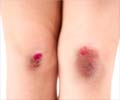
The scientists have reported that these two findings and a third discovery they made in the worms, involving genes that inhibit wound healing, could allow them to design ways to improve the healing of cuts and sores by possibly blocking the action of these inhibitory genes or finding ways to enhance the chemical signalling and wound healing process.
Chisholm and his postdoctoral fellow Suhong Xu took time-lapse movies of areas around the transparent worms where they punctured the skin with a needle or laser.
Then they monitored the calcium with a fluorescent protein so they could see how the calcium molecules spread from the point of injury.
They also developed genetic screens to pinpoint the specific calcium pathway or "channel" that is signalling the presence of the wound and stimulating the healing process.
"We think the channel is playing an important role in either sensing damage or responding to some other receptor that senses damage," the Daily Mail quoted Chisholm, the lead researcher as saying.
Advertisement
Chisholm thinks that the lowly roundworms have a delicate surface susceptible to injury and a rapid wound response mechanism that keeps their surface wounds from being fatal.
Advertisement
"But remarkably, they don't die when you do that because they have evolved ways to very rapidly close wounds to survive in the wild. In their natural environment, their predators try to exploit the worm's vulnerable exoskeleton. There are a whole group of fungi with tiny spikes that just sit around waiting for the worms to crawl over them so they can poke holes through their cuticle.
"For us, they are easy to work with, because worms are small, easy to grow and they're transparent, so when you put them on a slide, you can see the calcium clearly," he added.
The study will be published in the journal Current Biology.
Source-ANI











